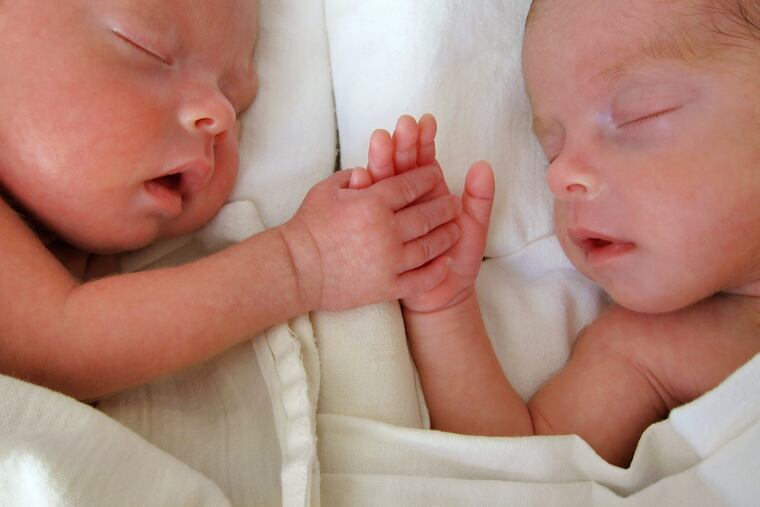Twin births in the U.S. finally decline as fertility treatment becomes more cautious
IVF has driven a problematic, three-decade increase in twins. Maybe the trend is reversing.

After climbing relentlessly for more than three decades, the U.S. twin birthrate has inched downward for the last four years, new federal data show.
The rate declined 1% a year between 2014 and 2018 — although that still translated to 123,536 twins born in 2018, or 32.6 duos for every 1,000 births.
The report from the National Center for Health Statistics doesn’t offer a reason for the apparent trend. But the best guesses are that the nation’s 480 IVF (in vitro fertilization) clinics have finally gotten serious about avoiding twins because dual births are far riskier and costlier than singletons.
The prescription for preventing pairs is simple: Put just one embryo at a time into the would-be mother.
“The declines in twin births are among older moms and white moms — groups that are more likely to have fertility treatment,” said epidemiologist Joyce Martin, lead author of the new report. “It does suggest an association” between the twin birthrate and IVF.
Twins can occur with old-fashioned reproduction and with fertility treatment that involves insemination, but experts agree IVF — in which eggs are fertilized in a lab dish — has driven the nation’s 79% increase in twins since 1980.
The latest report on IVF clinics bolsters the idea that IVF is now behind the national downturn. Twins made up less than 13% of the high-tech births in 2017 — down from 44% a year through much of the last decade.
“And I think it’s going to continue to improve. No question,” said Kevin Doody, a Bedford, Texas, fertility specialist and past president of the Society for Assisted Reproductive Technology (SART), which publishes the report on IVF clinics.
Beginning in 2004, SART and another professional group, the American Society for Reproductive Medicine (ASRM), have issued increasingly conservative guidelines for how many embryos to transfer to a patient’s womb. As a result, triplets and higher multiples are now a rarity — less than 0.3% of all IVF births.
» READ MORE: 'Social egg freezing' raises new questions about when it's too old to have a baby
» READ MORE: Why a gentler, less costly approach to IVF remains unpopular
But because IVF is usually not covered by health insurance and is largely unregulated in the United States, “single embryo transfer" has been a tough sell. Even though studies have shown that adding a second embryo doesn’t boost the odds of a birth for women with favorable profiles, both patients and doctors have been reluctant to give up the presumed hedge.
Historically, many couples viewed twins as an ideal outcome. And many doctors failed to stress the increased risks for mother and babies, including preeclampsia, cesarean section, prematurity, even death. (Not to mention that prenatal care, delivery, and the first year of medical care of twins cost about five times more than a singleton.)
So what has changed?
First, the technology for growing, selecting, and freezing embryos has improved.
“The tipping point happened a few years ago when success rates seemed high enough that it was reasonable” to rely on one embryo at a time, said Alan Penzias, a specialist at Boston IVF and chair of the ASRM practice committee.
Second, doctors — and social media — are doing a better job of explaining the realities to prospective patients.
“It’s been shown in multiple studies, when insurance covers IVF, patients’ acceptance of single-embryo transfer is uniform. Paying out-of-pocket, patients ask for more embryos,” said Larry Barmat, a fertility specialist at Abington Reproductive Medicine. “It’s our job to educate them that two embryos is not in their best interests.”
Penzias said, “I get so many fewer patients saying, ‘I want twins’ now than 15 years ago. There’s been a shift in perception.”
A third factor: In 2017, ASRM further refined its guidelines, recommending that only one embryo be used “in patients of any age" as long as they had favorable medical characteristics.
There is still plenty of room for improvement. The 2017 clinic report shows that while the majority of women under 35 — the most fertile age group — had single-embryo transfers, most women ages 35 to 40 had multiple embryos.
Also, a recent survey by FertilityIQ found more than a quarter of patients felt insufficiently informed about the risks of multiple births. FertilityIQ, a website aimed at patients, was founded by Deborah and Jake Anderson-Bialis after they went through treatment.
“As we work to understand why multiple-embryo transfer remains stubbornly high in the U.S., we would be wise to pay closer attention to how patients are being educated on the trade-offs of their treatment options,” concludes their survey.